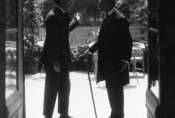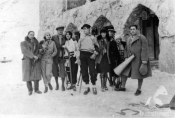Michał Waszyński

Director and film producer. He was born on September 29, 1904, in Kovel in Volyn and died on February 20, 1965, in Madrid. He came from a Hasidic family, his real name was Mosze Waks. In 1920, he performed in the Kiev Arlekin theatre and then attended acting course at the Cinema School of “Kinostudia” Film Society. He changed his name in 1922 at the instigation of Wiktor Biegański, whose assistant he was at the time (he played a major role in his film Zazdrość/Jealousy, completed in 1922). Later, he was an assistant to Ryszard Ordyński, Józef Lejtes, Henryk Szaro, Juliusz Gardan, and – in Berlin – Friedrich Wilhelm Murnau.
He made his debut as a director in 1929 with the melodrama Pod banderą miłości/Under the Flag of Love. He was an extremely prolific craftsman of cinema, until the outbreak of the Second World War – within ten years he had completed forty movies. He practiced genre cinema. He was particularly fond of comedy, working with the best pre-war comedians, including Adolf Dymsza (Dwanaście krzeseł/The Twelve Chairs 1933; Antek policmajster/Police Chief Antek, 1935; Wacus, 1935; Dodek na froncie/Dodek at the Front, 1936; Bolek i Lolek/Benny and Lenny, 1936), Antoni Fertner (Bolek i Lolek/Benny and Lenny, 1936; Papa się żeni/Papa's Wedding, 1936), and the Lviv duo Szczepcio and Tońcio, or Kazimierz Wajda and Henryk Vogelfanger (Będzie lepiej/It Will Be Better, 1936; Włóczęgi/Vagabonds, 1939). He made melodramas (Znachor/Quack, 1937; Professor Wilczur, 1938), exotic films (Głos pustyni/Voice of the Desert, 1932), thrillers (Prokurator Alicja Horn/Attorney Alice Horn, 1933; Kobiety nad przepaścią/Women Over the Precipice, 1938), as well as patriotic stories (Bohaterowie Sybiru/Heroes of Siberia, 1936). The Polish-Austrian co-production Kult ciała/The Cult of the Body (1930) brought him the Gold Medal at the festival in Nice and an adaptation of Znachor/Quack (1938) by Tadeusz Dołęga-Mostowicz – the Award of the Chamber of Commerce at the Eastern Fair in Lviv. He won particular acclaim for his Dybbuk (1937), based on the play by Szymon An-ski, filmed in Yiddish.
The outbreak of the Second World War found him in Lviv on the set of another film with Szczepcio and Tońcio. In 1941, he joined the army of General Władysław Anders, whose march to the Middle East he recorded – together with Konrad Tom – in the documentary Dzieci/Children (1943). A year later, he made the documentary Monte Cassino, and after the war – the Polish-Italian co-production Wielka droga/Long Road (1946), a melodramatic tale of lovers separated by the war, including documentary photographs from the battle of Monte Cassino. He spent the post-war years in Western Europe and the United States, collaborating with Orson Welles, Mervyn LeRoy, William Wyler, Joseph L. Mankiewicz, Nicholas Ray, Anthony Mann and Henry Hathaway.
Jerzy Armata
Selected filmography
-
1937
THE DYBBUK
-
1937
THE QUACK








